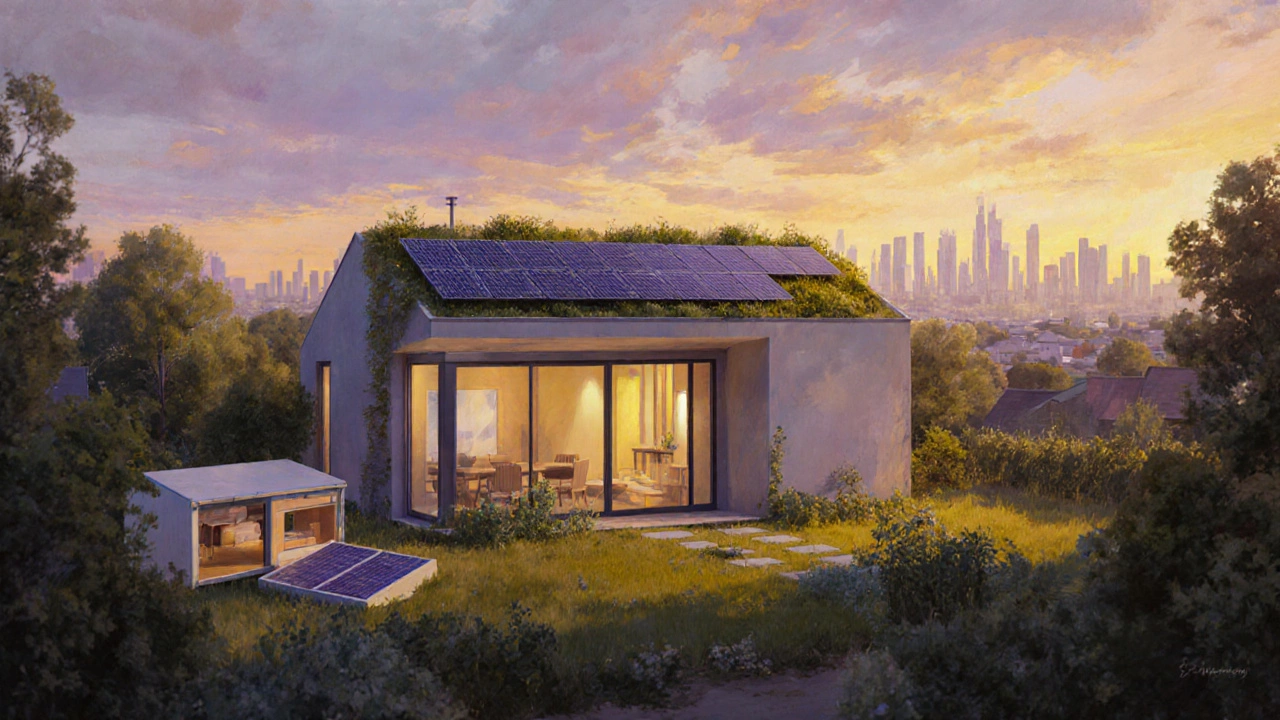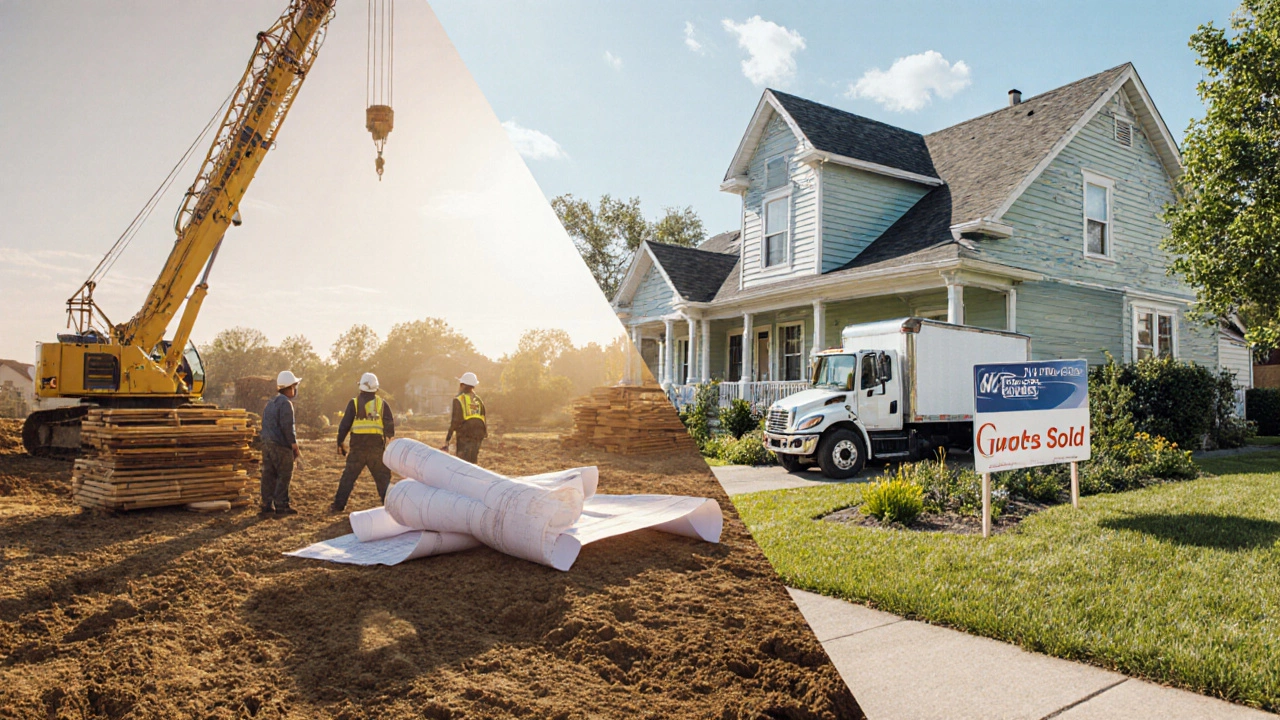Build vs Buy Cost Calculator
New Home Construction
Estimate the total cost of building a new home including land, materials, labor, and other expenses.
Existing Home Purchase
Estimate the total cost of buying an existing home including purchase price, taxes, and potential renovations.
Construction Inputs
Purchase Inputs
Construction Total
Total cost of building a new home
Purchase Total
Total cost of buying an existing home
Comparison Results
Cost Breakdown Comparison
| Cost Category | Construction (NZ$) | Purchase (NZ$) |
|---|---|---|
| Land | 0 | 0 |
| Materials | 0 | 0 |
| Labor | 0 | 0 |
| Permits & Fees | 0 | 0 |
| Contingency | 0 | 0 |
| Financing Interest | 0 | 0 |
| Temporary Housing | 0 | 0 |
| Hidden Repairs | 0 | |
| Moving Expenses | 0 | 0 |
| Total | 0 | 0 |
Key Takeaways
- On average, building a new home costs 5‑15% more than buying an existing property, but the gap narrows in high‑demand markets.
- Land price is the single biggest variable; cheap land can swing the balance in favor of building.
- Hidden costs-permits, site work, and design changes-add 10‑20% to a construction budget.
- Financing terms differ: construction loans often have higher rates but can be rolled into a mortgage once the build is complete.
- Long‑term value depends on location, build quality, and how well the design matches future resale trends.
Why the Question Matters Now
Housing markets have been on a roller‑coaster for the past few years. In 2025, supply shortages in major cities keep prices high, while construction material costs have finally steadied after a pandemic‑driven surge. That mix makes many prospective owners wonder whether the old adage “building is cheaper” still holds true.
Answering that question isn’t just about raw numbers; it’s about understanding the whole ecosystem of costs, timelines, and risks. Below we break down every piece of the puzzle so you can see clearly whether the build vs buy choice works for you.
Defining the Two Paths
First, let’s set the stage with clear definitions.
New Home Construction is a process that starts with buying land, securing permits, designing a floor plan, and then assembling a house from raw materials and labor. It typically involves a builder or contractor, a series of inspections, and a financing structure that may shift from a construction loan to a conventional mortgage.
Existing Home Purchase is the acquisition of a completed, occupied property that may need some repairs or upgrades but is move‑in ready. The buyer usually secures a standard mortgage, pays closing costs, and negotiates a price based on market comparables.
Breaking Down the Cost Components
Both routes share some cost categories-land, financing, and taxes-but each has its own unique line items.
1. Land Acquisition
Land is the biggest driver of the total price tag. In New Zealand’s Wellington suburbs, a 500m² lot can range from NZ$120,000 to over NZ$350,000 depending on zoning and view. In high‑growth Australian cities, that same parcel might top NZ$500,000.
When you buy an existing home, the land cost is baked into the sale price, but you still need to assess whether the location premium matches your budget.
2. Construction Materials
Average material costs in 2025 sit around NZ$2,200 per square metre for a mid‑range build (brick veneer, standard timber framing, basic finishes). Premium finishes-engineered stone countertops, high‑efficiency windows, or smart‑home wiring-can add NZ$300‑600 per m².
For an existing home, material costs appear as renovation expenses. A typical kitchen upgrade might cost NZ$25,000, but you only spend where you need it.
3. Labor
Labor rates have stabilized at roughly NZ$80‑$120 per hour for skilled trades. A 200‑m² house usually requires 2,000‑2,500 labor hours, translating to NZ$160,000‑NZ$300,000.
When buying, labor shows up as the cost of any needed repairs or upgrades. If the house is in good shape, labor expenses can be minimal.
4. Permits & Professional Fees
Local council development consent, building permits, and compliance inspections can total NZ$8,000‑NZ$15,000 for a standard residential project. Architectural and engineering services add another NZ$10,000‑NZ$25,000 depending on complexity.
These fees are rarely needed for an existing home purchase, except when you plan a major extension after moving in.
5. Financing Differences
Construction loans usually carry an interest rate 0.5‑1.0% higher than standard mortgages and require interest‑only payments during the build phase. Once the project is complete, you refinance into a regular mortgage, often with a 5‑year fixed rate of around 5.5% in 2025.
Buying an existing home typically means a straight‑through mortgage approval, with rates as low as 5.0% for a 30‑year term.
6. Hidden and Contingency Costs
Even the best‑planned build encounters surprises-soil remediation, unexpected weather delays, or design changes. Most builders recommend a 10‑15% contingency budget. That’s another NZ$30,000‑NZ$50,000 on a NZ$300,000 construction cost.
For existing homes, hidden costs show up as surprise repair bills after inspection-roof leaks, outdated wiring, or pest damage-often running NZ$5,000‑NZ$20,000.
Side‑by‑Side Cost Comparison (2025)
| Cost Category | New Home Construction (NZ$) | Existing Home Purchase (NZ$) |
|---|---|---|
| Land | 120,000 - 350,000 | Included in price (typically 20‑30% of total) |
| Materials | 440,000 - 500,000 | Irrelevant (unless renovating) |
| Labor | 160,000 - 300,000 | Variable (repairs 10,000 - 40,000) |
| Permits & Fees | 15,000 - 40,000 | 2,000 - 5,000 (transfer taxes) |
| Financing (interest over 5yr) | 45,000 - 70,000 | 35,000 - 55,000 |
| Contingency/Hidden | 30,000 - 50,000 | 5,000 - 20,000 |
| Total Approx. | 800,000 - 1,300,000 | 600,000 - 900,000 |
Numbers are averages for a 200m² home on a typical suburban lot. Your actual totals will vary based on land price, finish level, and local labor rates.
Timing and Lifestyle Considerations
A build can take 9‑18 months from breaking ground to handing over keys, assuming no major delays. During that period you may need to rent or stay with family, adding a hidden cost of temporary housing (often NZ$20,000‑NZ$40,000 for a year).
Buying an existing house lets you move in within weeks after settlement. That speed can be a decisive factor if you’re relocating for work or need to sell a previous property quickly.
Risk Profile: What Can Go Wrong?
Construction Delays are the most common risk, driven by weather, supply chain hiccups, or contractor availability. A six‑month delay can add NZ$30,000‑NZ$50,000 in financing costs and lost rent.
Market Fluctuations can affect both paths. If house prices rise sharply while you’re mid‑build, your finished home may be worth less than the market value at the time of purchase.
For existing homes, the biggest surprise is usually hidden defects that surface after settlement. A thorough pre‑purchase inspection can mitigate this, but it won’t catch every future issue.
When Building Beats Buying
- Cheap Land: If you already own a plot or find a low‑cost parcel far from the city center, the land expense drops dramatically.
- Customization Value: Tailoring layout, energy‑efficiency standards, or accessibility features can increase long‑term satisfaction and resale appeal.
- Energy Savings: New builds can incorporate passive solar design, high‑R insulation, and solar PV, cutting utility bills by up to 30%.
When Buying Beats Building
- High Land Costs: In markets where land commands 50%+ of the total price, buying an existing home often gives you more square footage for the same money.
- Time Sensitivity: If you need a home within three months, the purchase route is the only realistic option.
- Uncertain Financing: Construction loans require detailed budgets and staged draws; if your credit profile is borderline, a standard mortgage has better approval odds.

Decision‑Making Checklist
- Calculate the total cost of land you can realistically acquire.
- Estimate construction expenses using current NZ$2,200‑NZ$2,800 per m² for your desired finish level.
- Add a 12% contingency for unexpected items.
- Compare that sum to the median price of comparable existing homes in the same neighbourhood.
- Factor in time: rent or temporary housing costs if you choose to build.
- Assess your risk tolerance-are you comfortable with potential delays?
- Run both scenarios through a mortgage calculator to see monthly payments and total interest.
If the built‑home total (including land, contingency, and temporary housing) stays under the purchase price, you have a solid financial case for building.
Real‑World Example: Wellington Suburb
Jane and Tom wanted a 4‑bedroom family home in a leafy Wellington suburb. They found a 600m² block for NZ$250,000. Their design called for 210m² of living space with mid‑range finishes.
Using the 2025 averages:
- Materials: 210m² × NZ$2,350 = NZ$493,500
- Labor: 2,200hrs × NZ$100 = NZ$220,000
- Permits & Fees: NZ$18,000
- Contingency (12%): NZ$85,000
- Total construction cost: ≈ NZ$1,066,500
- Add land: NZ$250,000 → NZ$1,316,500
- Temporary rental (12months): NZ$30,000
- Financing interest (5.5% over 5yr): NZ$70,000
- Grand total: ≈ NZ$1,416,500
The nearest comparable existing home sold for NZ$1,200,000. After accounting for the extra NZ$216,500, Jane and Tom decided to buy the existing property, saving both money and a year of waiting.
Tips to Keep Costs Down, Whether You Build or Buy
- Negotiate land price: Even a small discount on a vacant lot can swing the balance.
- Standardize the floor plan: Using a builder’s stock design reduces architectural fees.
- Shop material alternatives: Engineered timber frames often cost less than solid hardwood while offering similar strength.
- Get multiple contractor bids: A 10‑15% spread is common, and you can leverage the lowest bid for better terms.
- Use a reputable inspector: For purchases, a thorough pre‑sale inspection uncovers hidden defects before you sign.
- Consider modular or panelized homes: Factory‑built sections can cut construction time by 30% and labor costs by up to 20%.
Future Outlook: How 2026 May Shift the Balance
Analysts predict that by early 2026, New Zealand’s housing supply will increase as more greenfield sites get rezoned. If land prices dip 5‑10%, the build option could become competitive again, especially for buyers seeking energy‑efficient homes.
At the same time, global timber prices are expected to rise modestly due to supply chain constraints, nudging material costs upward. Keep an eye on both trends; they’ll dictate whether the next year tips the scales.
Frequently Asked Questions
Is it usually cheaper to buy an existing house than to build a new one?
In most high‑demand markets, buying an existing home is cheaper because land takes up a larger share of the total cost. However, if you can secure low‑cost land or opt for a modest finish, building can approach parity.
What hidden costs should I budget for when building?
Add 10‑15% for contingencies, plus permits (NZ$8‑15k), design changes, soil remediation, and temporary housing while the build is underway.
How does financing differ between building and buying?
Construction loans are interest‑only and often cost 0.5‑1% more than regular mortgages. They also require staged draw inspections. Once the home is finished, you refinance into a standard mortgage.
Can I reduce construction costs by doing some work myself?
Yes, a DIY approach to non‑structural tasks (painting, landscaping, fixtures) can shave 5‑10% off the budget, but you must still budget for professional trades on anything that affects safety or code compliance.
What are the resale implications of a newly built home versus an older one?
New builds often retain value better if they incorporate modern energy standards and flexible floor plans. However, older homes in established neighborhoods can command premium prices due to location desirability.

